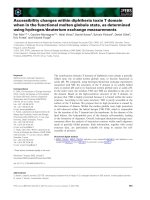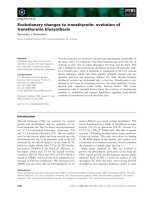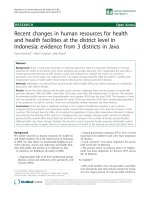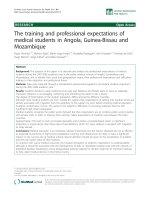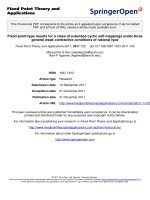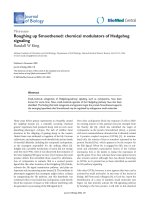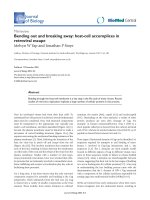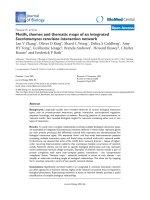Báo cáo sinh học: "Small changes, big results: evolution of morphological discontinuity in mammals" pps
Bạn đang xem bản rút gọn của tài liệu. Xem và tải ngay bản đầy đủ của tài liệu tại đây (133.73 KB, 4 trang )
Minireview
SSmmaallll cchhaannggeess,, bbiigg rreessuullttss:: eevvoolluuttiioonn ooff mmoorrpphhoollooggiiccaall ddiissccoonnttiinnuuiittyy iinn
mmaammmmaallss
Rodney L Honeycutt
Address: Natural Science Division, Pepperdine University, Malibu, California 90263-4321, USA. Email:
The orders of eutherian mammals are especially characterized
by morphological differences in the skull and dentition,
related to different requirements for processing food, and in
the postcranial skeleton, which is adapted for varied modes
of locomotion. The evolutionary biologist George Gaylord
Simpson [1] defined major morphological discontinuities
among higher taxa, specifically the orders of mammals, as
the result of macroevolution or ‘quantum evolution’. In
many cases, these discontinuities lack fossil evidence of tran-
sitions, appearing as what Simpson termed ‘breaks in the
fossil record’, and thus probably result from major adaptive
shifts. Along with the accepted processes of microevolu-
tionary change at the population level, Simpson also sug-
gested that mutations with large phenotypic effects “un-
questionably provide a theoretically excellent mechanism” for
large changes in morphology. These discontinuities, as well
as the short time periods associated with the diversification
of many mammalian orders, are still presenting a challenge
to paleontologists, geneticists and developmental biologists
attempting to reconstruct the ‘Mammal Tree of Life’, a first
step in understanding the geological and biological
processes that are responsible for mammalian diversity [2].
For many years now, differences in gene regulation rather
than dramatic differences in gene structure have been
proposed as the most probable explanations for morpho-
logical and functional differences, including those between
ourselves and our closest living primate relative, the
chimpanzee [3]. For example, genes involved in cranio-
facial muscle development [4], higher brain functions [5,6],
and speech and language [7] have been found to show
potentially significant differences in rate of evolution or
pattern of expression between chimps and humans.
LLiinnkkiinngg tthhee AAffrrootthheerriiaa ttooggeetthheerr
The superorder Afrotheria is another challenging case of
morphological discontinuity in mammalian evolution,
containing animals as morphologically distinct as elephants
and aardvarks. In a recent paper in BMC Biology, Asher and
Lehmann [8] now provide clinching evidence for one of the
few morphological and developmental traits so far identi-
fied as being common to members of this diverse group,
and suggest a possible candidate gene that may repay
further study.
The Afrotheria are a recently described group of African
origin containing the orders Proboscidea (elephants), Sirenia
(manatees and dugongs), Hyracoidea (hyraxes), Macroscelidea
(elephant shrews), Tubulidentata (aardvarks), and Afrosoricida
AAbbssttrraacctt
Comparative morphological and developmental studies, including a recent comparative study
of tooth development among the Afrotherian mammals, are indicating the types of genetic
mechanisms responsible for the evolution of morphological differences among major
mammalian groups.
BioMed Central
Journal of Biology
2008,
77::
9
Published: 18 March 2008
Journal of Biology
2008,
77::
9 (doi:10.1186/jbiol71)
The electronic version of this article is the complete one and can be
found online at />© 2008 BioMed Central Ltd
(golden moles of the family Chrysochloridae and tenrecs
and otter shrews of the family Tenrecidae). Despite the
obvious morphological differences distinguishing the
members of this superorder (Figure 1), extensive molecular
phylogenetic studies consistently support a monophyletic
origin for the Afrotheria (that is, the group all descend from
a single common ancestor) [9-14]. But there are few
unequivocal morphological synapomorphies (shared-
derived characteristics) supporting monophyly of this clade
[8, 15-17]. As indicated by Archibald [16], the superorder is
“not predicted by fossils”. This is especially the case for the
Afrosoricida, whose families were once aligned with the
insectivore group Lipotyphla. Novacek [17] indicates that
morphologically Afrotheria is “provocative”, suggesting a
“radical shakeout of the placental tree”.
Morphological investigations of Afrotheria are bearing fruit,
however, as revealed by Asher and Lehmann [8], who
provide evidence for the late eruption of the permanent
dentition as a synapomorphy uniting the Afrotheria. It was
known that tooth eruption in elephants, sea cows and
hyraxes occurs only after an individual reaches its adult
body size, unlike the situation in other mammals. But there
was no quantitative data on dental development in the
smaller Afrotherians. Asher and Lehmann [8] therefore
examined the relation of jaw size to the number of
permanent teeth using skulls of tenrecs and golden moles,
and were able to confirm the late eruption of the permanent
dentition in these animals.
Although the study of the genetics and developmental
biology of the Afrotheria is in its infancy, the authors draw a
comparison with a rare human developmental abnormality
to identify a candidate gene that deserves further study. The
human condition cleidocranial dysplasia (CCD), which
disfigures the facial features, has some morphological
similarities to traits held in common among Afrotheria,
including late tooth eruption. Several traits similar to those
associated with CCD (for example, delayed eruption of
teeth, vertebral anomalies, testicondy or non-descent of
male gonads, and reduction of clavicles) vary across various
groups of mammals and appear to be associated with
Afrotheria. Asher and Lehmann [8] used a phylogenetic
context to test for covariance of these CCD-like traits, with
the assumption that covariance is expected for traits
controlled by the same developmental pathway. Although
no significant covariance was detected, human and mouse
studies do reveal that mutations in the gene Runx2, which
encodes a transcription factor in the pathway controlling the
development of bones and teeth, are associated with CCD
[18,19], and Runx2 is a useful candidate gene for detailed
comparisons across the major categories of mammals,
including Afrotheria. As with many other examples, changes
in gene regulation probably account for morphological
similarities and differences among the Afrotheria.
SSuurrffaaccee ttoo aaiirr
Another, and more extensively studied, discontinuity in
mammals concerns the large morphological changes that
led to the evolution of flight in bats (Chiroptera) [20]. The
bat forelimb represents an airfoil that results from elon-
gation of digits, distal reduction of the radius and ulna,
development of wing membranes (patagia), and modifi-
cation of flight muscles and their innervation. Although
morphological and molecular studies [21, 22] provide a
phylogenetic framework for relationships among bat
families, less is known about the stages leading to the
development of this airfoil and the evolution of flight. True
flight undoubtedly originated early in chiropteran evolution,
as the oldest fossil bat known, Onchonycteris finneyi (dated
at 52.5 million years ago), has wing morphology similar to
modern bats (Figure 2) [23]. By comparative studies with
non-flying mammals, it is now clear that small changes in
the spatiotemporal pattern of gene expression during
development account for the dramatic changes represented
by the chiropteran forelimb [24-27], and the genes
responsible are beginning to be identified.
The continued elongation of digits in bat embryos
compared with mouse embryos seems to be associated with
the regulation of cartilage growth [24]. One candidate gene
involved in this morphological change is Bmp2 (bone
9.2
Journal of Biology
2008, Volume 7, Article 9 Honeycutt />Journal of Biology
2008,
77::
9
FFiigguurree 11
Superorder Afrotheria showing the presumed relationships among the
various orders. Some of the relationships are not well confirmed. There
is support for the group Paenungulata, containing Hyracoidea (hyraxes,
elephants, and manatees/sea cows), Tethytheria (elephants and
manatees/sea cows), Afrosoricida (families Tenrecidae (tenrecs) and
Chrysochloridae (golden moles)).
morphogenic protein 2), which encodes a secreted signaling
protein associated with the regulation of chondrogenesis.
Expression of this gene is upregulated in bat development
compared with that of the mouse [25]. Another candidate
gene is Prx1 (paired-box), which encodes a transcription
factor associated with growth of limb bones. A transgenic
mouse with a bat Prx1 enhancer showed an increase in limb
length apparently resulting from the upregulation of the
endogenous mouse Prx1 gene in cartilage [26].
Separation of the digits in vertebrates involves programmed
cell death of the interdigital mesenchyme. While this occurs
in the bat hindlimb, it is inhibited in the forelimb, resulting
in the development of the patagium. This inhibition is due to
differential inhibition of the Bmp signaling pathway in the
embryonic forelimb, which is also characterized by high
levels of expression of the signaling protein fibroblast growth
factor 8 [27]. Although the processes responsible for the
evolution of powered flight in mammals are not yet known
in detail, these comparative studies indicate that small
changes in the timing and extent of expression in key genes
can have large developmental effects [25]. Perhaps unraveling
the developmental processes will provide a clearer picture of
the transition from non-volant locomotion to powered flight.
LLiinnkkiinngg ggeennoottyyppee aanndd pphheennoottyyppee
A range of comparative studies, involving population
genetics, genomics, proteomics, and gene-expression
profiling, are now both unraveling the regulatory processes
and identifying candidate genes responsible for morpho-
logical discontinuities in mammals and other organisms.
Rather than simple mutations within structural genes, many
of the mechanisms underlying change represent more subtle
and complex changes involving gene regulation. Complex
anatomical differences such as those defining the higher
categories of mammals, as well as differences between more
closely related species, are likely to be the result of
interacting pathways that regulate gene expression during
development. Changes in gene regulation seem important
for a host of phenotypic differences in mammals and other
organisms [28,29]. In addition, phenotypic change could
result from changes such as expansion and contraction of
gene families or alternative splicing of RNA transcripts.
Understanding how changes in gene regulation can alter the
phenotype will be considerably more challenging than
investigating structural gene changes [30], and it will require
a clear methodology for the identification of candidate
genes as well as the dissection of pathways and networks
responsible for the development of complex traits.
Whole-genome comparisons and in vivo developmental
studies provide two experimental means of addressing
these problems. For mammals, this means that future
progress will still largely rely on well-understood model
organisms such as the mouse, and on what we can learn
from human pathologies [31]. The genetic hypotheses
proposed for the Afrotheria and other mammals are only
the beginning; in the future, an increased understanding of
how regulatory changes alter phenotype should help to
determine whether Simpson’s hypothesis of morphological
discontinuity holds up.
AAcckknnoowwlleeddggeemmeennttss
I thank Nancy B Simmons of the American Museum of Natural History
for permission to use the photograph of
Onychonycteris finneyi
. Pho-
tographs of the aardvark, elephant shrew (photographer Olaf Leillinger),
manatee (US Geological Survey), tenrec (photographer Wilfried Berns:
CC-BY-SA-2.0-DE), and golden mole in Figure 1 were obtained from
Wikipedia ( The photo-
graph of Africa is from NASA. Photographs of the hyrax and elephant
were provided by the author.
RReeffeerreenncceess
1. Simpson GG:
Tempo and Mode in Evolution
. New York: Hafner
Publishing Company; 1965.
/>Journal of Biology
2008, Volume 7, Article 9 Honeycutt 9.3
Journal of Biology
2008,
77::
9
FFiigguurree 22
Fossil bat,
Onchonycteris finneyi,
collected from Green River formation
in Wyoming. Photograph courtesy Nancy B Simmons.
2.
TThhee MMaammmmaall TTrreeee ooff LLiiffee PPrroojjeecctt
[]
3. King MC, Wilson AC:
EEvvoolluuttiioonn aatt ttwwoo lleevveellss iinn hhuummaannss aanndd cchhiimm
ppaannzzeeeess
Science
1975,
118888::
107-116.
4. Stedman HH, Kozyak BW, Nelson A, Thesier DM, Su LT,
Low DW, Bridges CR, Shrager JB, Minugh-Purvis N, Mitchell MA:
MMyyoossiinn ggeennee mmuuttaattiioonn ccoorrrreellaatteess wwiitthh aannaattoommiiccaall cchhaannggeess iinn tthhee
hhuummaann lliinneeaaggee
Nature
2004,
442288::
415-418.
5. Rockman MV, Hahn MW, Soranzo N, Zimprich F, Goldstein DB,
Wray GA:
AAnncciieenntt aanndd rreecceenntt ppoossiittiivvee sseelleeccttiioonn ttrraannssffoorrmmeedd
ooppiiooiidd
cciiss
rreegguullaattiioonn iinn hhuummaannss
.
PLoS Biol
2005,
33::
2208-2219.
6. Pollard KS, Salama SR, Lambert N, Lambot M-A, Coppens S,
Pedersen JS, Katzman S, King B, Onodera C, Siepel A, Kern AD,
Dehay C, Igel H, Ares M, Vandereghan P, Haussler D:
AAnn RRNNAA
ggeennee eexxpprreesssseedd dduurriinngg ccoorrttiiccaall ddeevveellooppmmeenntt eevvoollvveedd rraappiiddllyy iinn
hhuummaannss
Nature
2006,
4444::
167-172.
7. Enard W, Przeworski M, Fisher SE, Lai CSL, Wiebe V, Kitano T,
Monaco AP, Pääbo S:
MMoolleeccuullaarr eevvoolluuttiioonn ooff FFOOXXPP22,, aa ggeennee
iinnvvoollvveedd iinn ssppeeeecchh aanndd llaanngguuaaggee
Nature
2002,
441188::
869-872.
8. Asher RJ, Lehmann T:
DDeennttaall eerruuppttiioonn iinn aaffrrootthheerriiaann mmaammmmaallss
BMC Biol
2008,
66::
14.
9. Springer MS, Cleven GC, Madsen O, de Jong WW, Waddell VG,
Amrine HM, Stanhope MJ:
EEnnddeemmiicc AAffrriiccaann mmaammmmaallss sshhaakkee tthhee
pphhyyllooggeenneettiicc ttrreeee
Nature
1997,
338888::
61-64.
10. Stanhope MJ, Madsen O, Waddell VG, Cleven GC, de Jong WW,
Springer MS:
HHiigghhllyy ccoonnggrruueenntt mmoolleeccuullaarr ssuuppppoorrtt ffoorr aa ddiivveerrssee
ssuuppeerroorrddiinnaall ccllaaddee ooff eennddeemmiicc AAffrriiccaann mmaammmmaallss
Mol Phylogenet
Evol
1998,
99::
501-508.
11. Stanhope MJ, Waddell VG, Madsen O, de Jong WW, Hedges SB,
Cleven GC, Kao D, Springer MS:
MMoolleeccuullaarr eevviiddeennccee ffoorr mmuullttii
ppllee oorriiggiinnss ooff IInnsseeccttiivvoorraa aanndd ffoorr aa nneeww oorrddeerr ooff eennddeemmiicc
AAffrriiccaann iinnsseeccttiivvoorree mmaammmmaallss
Proc Natl Acad Sci USA
1998,
9955::
9967-9972.
12. Murphy WJ, Eizirik E, O’Brien SJ, Madsen O, Scally M, Douady CJ,
Teeling E, Ryder OA, Stanhope MJ, de Jong WW, Springer MS:
RReessoolluuttiioonn ooff tthhee eeaarrllyy ppllaacceennttaall mmaammmmaall rraaddiiaattiioonn uussiinngg BBaayyeessiiaann
pphhyyllooggeenneettiiccss
Science
2001,
229944::
2348-2351.
13. Wildman DE, Uddin M, Opazo JC, Liu G, Lefort V, Guindon S,
Gascuel O, Grossman LI, Romero R, Goodman M:
GGeennoommiiccss,, bbiioo
ggeeooggrraapphhyy,, aanndd tthhee ddiivveerrssiiffiiccaattiioonn ooff ppllaacceennttaall mmaammmmaallss
Proc Natl
Acad Sci USA
2007,
110044::
14395-14400.
14. Kjer KM, Honeycutt RL:
SSiittee ssppeecciiffiicc rraatteess ooff mmiittoocchhoonnddrriiaall
ggeennoommeess aanndd tthhee pphhyyllooggeennyy ooff EEuutthheerriiaa
BMC Evol Biol
2007,
77::
8.
15. Asher RJ, Novacek MJ, Geisler JH:
RReellaattiioonnsshhiippss ooff eennddeemmiicc
AAffrriiccaann mmaammmmaallss aanndd tthheeiirr ffoossssiill rreellaattiivveess bbaasseedd oonn mmoorrpphhoollooggiiccaall
aanndd mmoolleeccuullaarr eevviiddeennccee
J Mammalian Evol
2003,
1100::
131-194.
16. Archibald JD:
TTiimmiinngg aanndd bbiiooggeeooggrraapphhyy ooff tthhee eeuutthheerriiaann rraaddiiaattiioonn::
ffoossssiillss aanndd mmoolleeccuulleess ccoommppaarreedd
Mol Phylogenet Evol
2288::
350-359.
17. Novacek MJ:
MMaammmmaalliiaann pphhyyllooggeennyy:: ggeenneess aanndd ssuuppeerrttrreeeess
Curr
Biol
2001,
1111::
573-575.
18. Otto F, Kanegane H, Mundlos S:
MMuuttaattiioonnss iinn tthhee RRUUNNXX22 ggeennee
iinn ppaattiieennttss wwiitthh cclleeiiddooccrraanniiaall ddyyssppllaassiiaa
.
Hum Mutat
, 2002,
1199
:209-216.
19. Aberg T, Wang X-P, Kim J-H, Yamashiro T, Bei M, Rice R,
Ryoo H-M, Thesleff I:
RRuunnxx22
mmeeddiiaatteess FFGGFF ssiiggnnaalliinngg ffrroomm eeppiitthhee
lliiuumm ttoo mmeesseenncchhyymmee dduurriinngg ttooootthh mmoorrpphhooggeenneessiiss
Dev Biol
, 2004,
227700::
76-93.
20. Simmons NB:
TThhee ccaassee ffoorr cchhiirroopptteerraann mmoonnoopphhyyllyy
Am Mus Novit
1994,
33110033::
1-54.
21. Simmons NB:
BBaatt pphhyyllooggeennyy:: aann eevvoolluuttiioonnaarryy ccoonntteexxtt ffoorr ccoommppaarraa
ttiivvee ssttuuddiieess
In
Ontogeny, Functional Ecology, and Evolution of
Bats
. Edited by Adams R, Pederson S. Cambridge, UK: Cambridge
University Press; 2000:9-58.
22. Teeling EC, Springer MS, Madsen O, Bates P, O’Brien SJ,
Murphy WJ:
AA mmoolleeccuullaarr pphhyyllooggeennyy ffoorr bbaattss iilllluummiinnaatteess bbiiooggeeooggrraa
pphhyy aanndd tthhee ffoossssiill rreeccoorrdd
Science
2005,
330077::
580-584.
23. Simmons NB, Seymour KL, Harbersetzer J, Gunnell GF:
PPrriimmiittiivvee
eeaarrllyy EEoocceennee bbaatt ffrroomm WWyyoommiinngg aanndd tthhee eevvoolluuttiioonn ooff fflliigghhtt aanndd
eecchhoollooccaattiioonn
Nature
2008,
445511::
818-822.
24. Sears KE, Behringer RR, Rasweiler JJ, Niswander LA:
DDeevveellooppmmeenntt
ooff bbaatt fflliigghhtt:: mmoorrpphhoollooggiicc aanndd mmoolleeccuullaarr eevvoolluuttiioonn ooff bbaatt wwiinngg
ddiiggiittss
Proc Natl Acad Sci USA
2006,
110033::
6581-6586.
25. Sears KE:
MMoolleeccuullaarr ddeetteerrmmiinnaannttss ooff bbaatt wwiinngg ddeevveellooppmmeenntt
Cells
Tissues Organs
2008,
118877::
6-12.
26. Cretekos CY, Wang Y, Green ED, NISC Comparative Sequencing
Program, Martin JF, Rasweiler JJ, Behringer RR:
RReegguullaattoorryy ddiivveerr
ggeennccee mmooddiiffiieess lliimmbb lleennggtthh bbeettwweeeenn mmaammmmaallss
Genes Dev
2008,
2222::
141-151.
27. Weatherbee SD, Behringer RR, Rasweiler JJ, Niswander LA:
IInntteerr
ddiiggiittaall wweebbbbiinngg rreetteennttiioonn iinn bbaatt wwiinnggss iilllluussttrraatteess ggeenneettiicc cchhaannggeess
uunnddeerrllyyiinngg aammnniioottee lliimmbb ddiivveerrssiiffiiccaattiioonn
Proc Natl Acad Sci USA
2006,
110033::
15103-15107.
28. Chabot A, Shrit R A, Blekhman R, Gilad Y.
UUssiinngg rreeppoorrtteerr ggeennee
aassssaayyss ttoo iiddeennttiiffyy
cciiss
rreegguullaattoorryy ddiiffffeerreenncceess bbeettwweeeenn hhuummaannss aanndd
cchhiimmppaannzzeeeess
Genetics
2007,
117766::
2069-2076.
29. Wittkopp PJ, Haerum BK, Clark AG:
EEvvoolluuttiioonnaarryy cchhaannggeess iinn
cciiss
aanndd
ttrraannss
ggeennee rreegguullaattiioonn
Nature
2004,
443300::
85-88.
30. Wray GA, Hahn MW, Abouheif E, Balhoff JP, Pizer M, Rockman MV,
Romano LA:
TThhee eevvoolluuttiioonn ooff ttrraannssccrriippttiioonnaall rreegguullaattiioonn iinn eeuukkaarryy
ootteess
Mol Biol Evol
2003,
2200::
1377-1419.
31. Carroll SB:
GGeenneettiiccss aanndd tthhee mmaakkiinngg ooff
HHoommoo ssaappiieennss
Nature
2003,
442222::
849-857.
9.4
Journal of Biology
2008, Volume 7, Article 9 Honeycutt />Journal of Biology
2008,
77::
9
